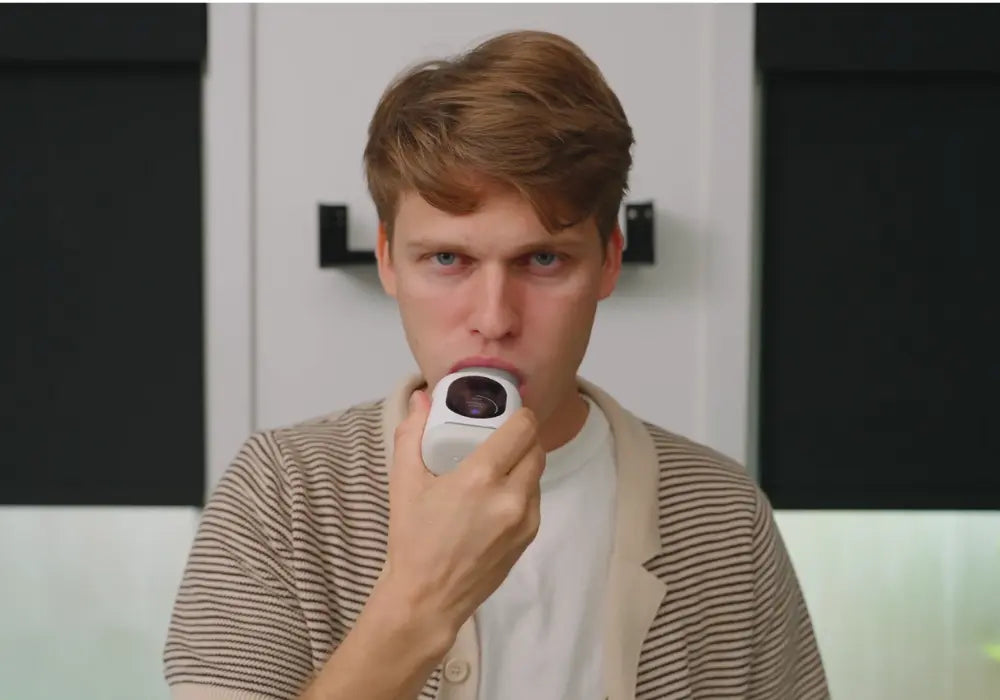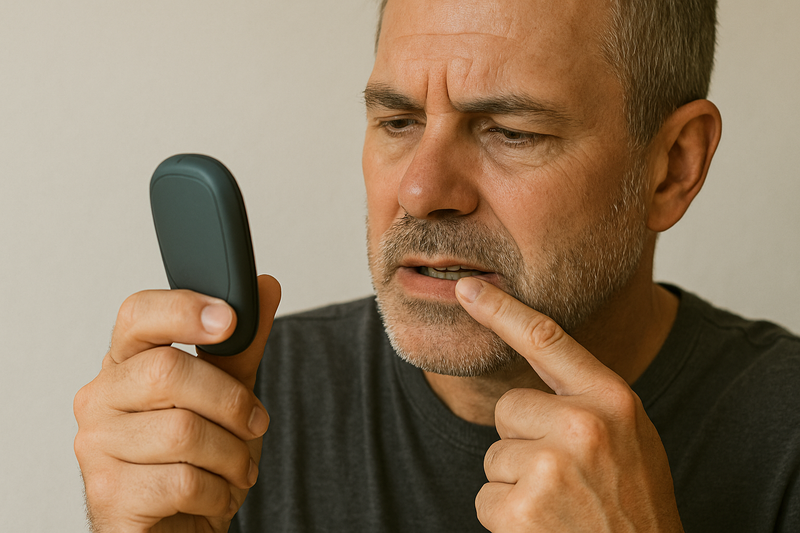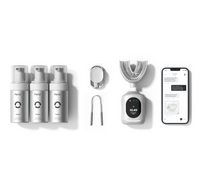
11 min read
The Benefits of AI-Powered Oral Health Reports and Coaching
Artificial intelligence is transforming many aspects of healthcare, including dental care. AI oral health technology integrates sophisticated algorithms with everyday dental practices to enhance the way we manage our oral hygiene. From providing detailed insights to offering personalized advice, AI empowers individuals to take control of their dental health with unprecedented precision. This advancement simplifies oral care routines and helps prevent common dental issues before they become severe.
Understanding AI Oral Health Reports
How AI Analyzes Brushing Habits
AI technology in oral care devices, such as smart toothbrushes with coaching, employs data analytics to observe and record brushing habits. This data is then analyzed to identify patterns and trends in an individual's brushing technique and frequency. By understanding these habits, AI can pinpoint areas for improvement, such as increasing brushing time on neglected teeth or adjusting the brushing angle for better plaque removal. This deep dive into personal habits allows users to refine their approach for optimal oral health.

The Benefits of AI Dental Reports
The personalized reports generated by AI-powered oral care systems offer tailored advice based on individual dental health data. These reports highlight specific concerns like areas with frequent plaque buildup, offering actionable insights tailored to the user's needs. Having such detailed and personalized information helps individuals and their dental professionals make better-informed decisions about treatments and preventive care, ultimately enhancing oral hygiene and health.
Oral Health Data Analysis
This goes beyond basic tracking; it involves a comprehensive review of factors affecting an individual’s dental health, including plaque levels, gum status, and potential disease risk factors. AI tools assess this data to provide a holistic view of one's oral health, identifying areas susceptible to problems. A proactive approach prevents serious conditions, offering a roadmap for maintaining or achieving healthy gums and teeth.
Using AI to Identify Early Signs of Oral Health Issues
Early detection is crucial in preventing severe dental problems. AI excels in this by analyzing subtle changes over time that might not be immediately obvious to individuals. Tools equipped with AI for gum disease prevention can alert users to the earliest signs of gum inflammation or decay. Early warning systems enable prompt action, such as adjusting one’s diet or hygiene habits, to prevent potential issues before they require significant medical intervention.
The Power of AI Dental Coaching for Better Brushing
Real-Time Feedback
One of the standout features of ultrasonic toothbrushes is their ability to give real-time feedback. This feature informs users if they are brushing too hard, which can damage gums and enamel, or too softly, which might not be effective at plaque removal. It also tracks the duration and coverage, ensuring every part of the mouth receives adequate attention. A feedback loop educates users and promotes the development of healthy brushing habits that stick.
Smart Toothbrushes with Coaching Features
These devices use a combination of hardware and software to transform brushing habits through detailed analysis and real-time feedback. Here's how they typically operate:
- Sensors: Modern smart toothbrushes incorporate sophisticated sensors that continuously monitor every aspect of your brushing routine. These are embedded within the brush head and handle, capturing detailed metrics such as the angle of the brush, the speed of each stroke, and the amount of pressure applied. In addition to motion sensors that detect the brush’s movements in multiple directions, pressure sensors provide crucial data by ensuring that the user does not exert excessive force, which can lead to enamel wear or gum irritation. This sensitive technology translates physical motions into quantifiable data, offering insights that help tailor the brushing experience to individual needs. By detecting subtle variations in technique, the sensors contribute to a more precise evaluation of oral hygiene practices. The collected data is not merely raw numbers; it forms the basis for actionable recommendations that inform users how to adjust their habits for improved effectiveness. This level of monitoring transforms a routine task into an intelligent process where each brushstroke is analyzed, allowing users to understand and optimize their technique over time.
- Data Syncing: The seamless transfer of brushing data is a cornerstone of the smart toothbrush ecosystem, ensuring that all recorded metrics are promptly relayed to a secure cloud-based database. Every brushing session generates a comprehensive set of data points, including duration, frequency, pressure, and coverage patterns, which are automatically synced with the user’s digital profile. This continuous data flow allows the system to maintain an up-to-date record of oral hygiene performance, fostering an environment where information is readily available for review. The synchronization process is engineered to be both efficient and secure, protecting sensitive health data while ensuring smooth integration with the user’s device. Once the data is transferred, it becomes a resource for the device’s intelligent coaching algorithms, enabling a deep analysis of brushing habits over time.
- Progress Tracking: Each brushing session is logged and compiled into detailed reports that reveal trends in brushing duration, frequency, pressure, and coverage over weeks and months. This accumulated data is then presented in the form of interactive charts and graphs, offering a clear visual representation of the user’s journey toward better oral health. The progress tracking function is designed to motivate and inspire by highlighting incremental improvements and pinpointing areas that may need further attention. Over time, users can compare their current performance with historical data, enabling them to appreciate the cumulative benefits of adopting a smarter brushing routine. The RHE system often includes milestones and rewards that recognize consistent adherence to healthy habits, adding a gamified element to the overall experience.
This intelligent approach optimizes brushing techniques and fosters a proactive attitude toward long-term dental health, ensuring that every user can achieve and maintain a confident, healthy smile.
Customizing Brushing Routines
Through detailed dental health tracking, AI-powered devices can recommend custom brushing routines tailored to each user’s specific needs. Whether focusing more on molars or adjusting the brushing time for certain areas, these recommendations are based on individual habits and problem areas identified by AI. Users benefit from a regimen that adapts to their oral health needs over time, optimizing their daily routine for the best possible outcomes.
AI-Powered Smart Toothbrush Innovations
The Best AI Toothbrushes
The market offers a variety of the best AI toothbrush models, each designed to cater to different needs and preferences. These devices typically include features such as 3D tracking to monitor brushing efficiency across different areas of the mouth, pressure sensors to prevent gum damage, and timers to promote adequate brushing time. The benefits of using these advanced toothbrushes are comprehensive, from improving oral hygiene to offering insights that can lead to better dental visits, ultimately enhancing overall dental health and wellness.
How Electric Toothbrushes with Apps Improve Oral Hygiene
These toothbrushes connect to mobile applications that provide users with a wealth of information about their habits. Users can see precisely which areas of their mouth are being neglected and receive improvement tips. Also, these apps often include gamification elements, which can motivate users, especially younger ones, to maintain consistent brushing routines.

Innovations in Toothbrushes
As we look to the future, the potential for innovation in oral hygiene with AI continues to expand. Here’s what we might expect next from smart dental care:
- Automated Adjustments: Envision a toothbrush that intelligently calibrates its bristle stiffness, vibration frequency, and even the chosen brushing mode based on real-time assessments of your dental health. For instance, if sensors detect that your gums are particularly sensitive on a given day, the device could automatically switch to a gentler cleaning mode with softer bristles and lower vibration intensity, ensuring comfort without sacrificing cleaning efficiency. This level of automation would remove the guesswork from daily oral hygiene routines, allowing the device to respond dynamically to subtle changes in gum condition, enamel integrity, or plaque buildup. The system might utilize historical brushing data combined with real-time feedback to make instantaneous adjustments that optimize performance during every session. As a result, users would experience a more personalized and effective brushing routine without manually selecting settings. Automated adjustments could help reduce the risk of overbrushing or under-cleaning by maintaining an ideal balance that is uniquely suited to each individual's dental profile.
- Voice-Activated Features: With voice recognition technology integrated into the device, users could effortlessly control settings, receive real-time coaching, or even ask for personalized tips without interrupting their brushing routine. Imagine starting your session by simply saying, "Begin cleaning," and having the toothbrush immediately adjust to your preset preferences. This technology could also provide audible reminders for proper brushing techniques, such as encouraging you to cover a neglected quadrant or warning against excessive pressure. Voice-activated commands could be further integrated with mobile apps, allowing users to ask for detailed feedback or access historical brushing data simply by speaking into their device. Moreover, the integration of voice control opens up the possibility of multilingual support, making advanced oral care accessible to a wider audience across different regions. Interacting verbally with the toothbrush enhances the user experience by providing a more intuitive and engaging interface, reducing the need for manual adjustments. This feature could support accessibility, offering a valuable tool for individuals with limited dexterity or vision impairments, ensuring they receive the same level of personalized care.
- Eco-Friendly Options: As environmental concerns take center stage in consumer decision-making, the future of smart toothbrushes is likely to include a range of eco-friendly options that prioritize sustainability without compromising on performance. These innovative models may be constructed from biodegradable materials, such as plant-based polymers or sustainably harvested bamboo, offering a more environmentally responsible alternative to conventional plastic components. Manufacturers could also explore designs that minimize waste through modular construction, where only the brush head needs replacement instead of the entire unit, thus reducing the volume of discarded electronic waste. Eco-friendly toothbrushes might incorporate energy-efficient charging systems and recyclable packaging to lower their environmental impact further. Users who are environmentally conscious will find these options particularly appealing, as they align with broader goals of reducing plastic waste and supporting a circular economy. Beyond the materials, these eco-friendly models may also feature smart technology that optimizes energy consumption, ensuring that the device operates efficiently and lasts longer.
Embracing these cutting-edge developments will empower users to achieve superior oral health while contributing to a healthier and more environmentally conscious future.
Broadening the Horizons: AI in Other Dental Devices
Dental Imaging Equipment
X-rays, CT scans, and MRI machines represent a significant leap forward in diagnostic accuracy. AI algorithms analyze images with detail beyond human capability, identifying early signs of issues like cavities, bone loss, and hidden infections. This detection leads to timely and more effective treatments, significantly improving patient outcomes and reducing the risk of complications.
Dental Scanners for Accurate Impressions
Scanners equipped with AI technology are transforming the way dental impressions are taken. These advanced scanners provide highly accurate digital impressions that are essential for creating precise dental appliances like crowns, bridges, and aligners. AI-powered oral care through these scanners ensures a perfect fit and faster production times, greatly enhancing patient comfort and satisfaction with prosthetic and orthodontic treatments.
Smart Flossing Devices
Flossing is a critical component of oral hygiene that involves using a thin filament, typically made of plastic or nylon, to remove food particles, plaque, and bacteria from between the teeth and along the gum line where a toothbrush cannot reach. Regular flossing helps prevent gum disease, tooth decay, and halitosis (bad breath) by disrupting and removing the build-up of plaque, a sticky, colorless film of bacteria that forms on the teeth. Often overlooked in daily oral hygiene routines is getting a high-tech makeover with AI. Smart flossing devices equipped with AI can track flossing frequency, duration, and effectiveness, providing feedback and suggestions for improvement. By promoting better flossing habits, these devices play a crucial role in preventing gum disease and improving overall dental health.

AI-powered devices utilize advanced algorithms to analyze brushing habits and oral health trends, providing personalized feedback and reports. This technology enables the early detection of potential issues, allowing for timely intervention that can prevent severe dental problems. A smart toothbrush with coaching enhances brushing techniques and overall oral care. Its integration into dental healthcare promises more innovations that will further enhance our ability to maintain optimal oral health. Embracing these empowers us to improve our dental routines and revolutionize the entire approach to oral health maintenance and disease prevention.
Share




